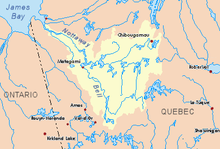| Cawcot | |
|---|---|
 Watershed of Nottaway River | |
| Location | |
| Country | Canada |
| Province | Quebec |
| Region | Nord-du-Québec |
| Physical characteristics | |
| Source | Confluence of two forested lakes |
| • location | Eeyou Istchee James Bay (municipality), Nord-du-Québec, Quebec |
| • coordinates | 49°04′30″N 74°44′26″W / 49.07500°N 74.74056°W |
| • elevation | 450 m (1,480 ft) |
| Mouth | Gabriel Lake (Opawica River tributary) |
• location | Eeyou Istchee James Bay (municipality), Nord-du-Québec, Quebec |
• coordinates | 49°18′22″N 74°28′22″W / 49.30611°N 74.47278°W |
• elevation | 392 m (1,286 ft) |
| Length | 44.2 km (27.5 mi)[1] |
| Basin features | |
| Tributaries | |
| • left | (upstreams)
|
The Cawcot River is a tributary of Gabriel Lake, flowing into the municipality of Baie-James, Jamésie, in the administrative region of Nord-du-Québec, Quebec, Canada.
This river crosses successively the cantons of Chambalon, Beaucours, Crisafy. Forestry is the main economic activity of the sector; recreational tourism activities, second. A logging camp has been established on the west bank of Lake Ventadour near the forest road.
The south of the Cawcot River Valley is served by route 212 which connects Obedjiwan to La Tuque and passes south of Lake Dubois. From there, the forest road R1032 (North–south direction) passes over the strip of land between the Queue de Castor River and the Ventadour River.
The surface of the Cawcot River is usually frozen from early November to mid-May, however, safe ice movement is generally from mid-November to mid-April.
- ^ "Atlas of Canada". atlas.nrcan.gc.ca. Archived from the original on 2008-10-14. Retrieved 2018-01-13.